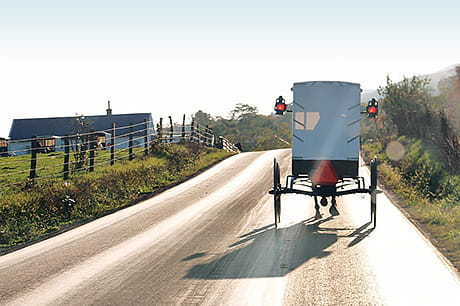Rattlesnake bite: What to do if it happens to you
Heading outdoors but worried about snakebites? They’re rare, but be prepared.
Going outdoors to get some sun and fresh air is always healthy, right? As long as you’re prepared, you can brave sunburn, a poison ivy rash — and once in a while, something a little more dangerous.
Two species of rattlesnake slither around Pennsylvania. If you’re hiking or gardening near their habitat, you may encounter one. The timber rattlesnake is more common, with verified sightings throughout most of the state in rocky or forested areas. The endangered Eastern massasauga is only found in a few western counties and sticks to lower-lying swampy land.
Rattlesnakes aren’t aggressive, but they will bite if they’re startled or feel threatened. Fortunately, they usually give a warning in the form of a buzzing rattle made by shaking their tail tips. But not always.
When it bites, a rattlesnake’s fangs inject venom into its rodent prey — or the ankle of an unsuspecting hiker who steps over a log and into its personal space.
What do you do if you’re bitten by a snake?
Try to get a good look at (or a picture of) the culprit. The snake’s approximate size, color, pattern and other details can tell medical professionals whether you need antivenin treatment.
If you do know it was a rattlesnake bite:
- Don’t panic. Staying calm not only helps you think more clearly, but it slows the venom’s spread through your bloodstream.
- Call 911 or get to an emergency room as soon as possible. Most people recover fully from rattlesnake bites if they’re treated quickly.
- Lie or sit down while waiting for emergency responders. Keep the bitten body part below the level of your heart.
- Wash the bite with warm, soapy water and cover it with gauze or a Band-Aid.
Snakebite symptoms
Rattlesnake venom has a traumatic effect on the body. Some proteins destroy tissues while others cause hemorrhaging. Besides the two small fang wounds in the skin, according to the Centers for Disease Control and Prevention, venomous snakebite symptoms include:
- Redness and swelling
- Severe pain
- Nausea and vomiting
- Difficulty breathing
- Trouble seeing
- Excess salivation and sweating
- Numbness or tingling
Snakebite “treatments” to avoid
Forget all the old advice about how to treat a venomous snakebite. Cutting an X shape over each fang puncture or sucking out the venom are not smart ideas. Don’t use a tourniquet or put ice on the bite, either. Finally, don’t drink alcohol or caffeine. These so-called treatments will do more harm than good.
An ounce of prevention
When you live near rattlesnakes, the best thing you can do is know where they’re likely to be. Look before you leap (or step, reach or kneel), especially near wood or rock piles and fallen logs. And since they’re well-camouflaged, keep an ear out for their buzzy, hissy rattle, too.
If you see a rattlesnake, keep a respectful distance and let it be. Because they eat rats and mice, they’re actually helpful to farmers and homeowners. Like a lot of us, they just want to be left in peace to enjoy the sun.
Next steps:
Exercise tips to get fit, safely
How to remove a tick
Learn your options for getting care when you need it





